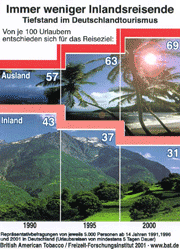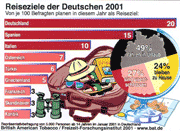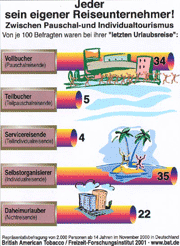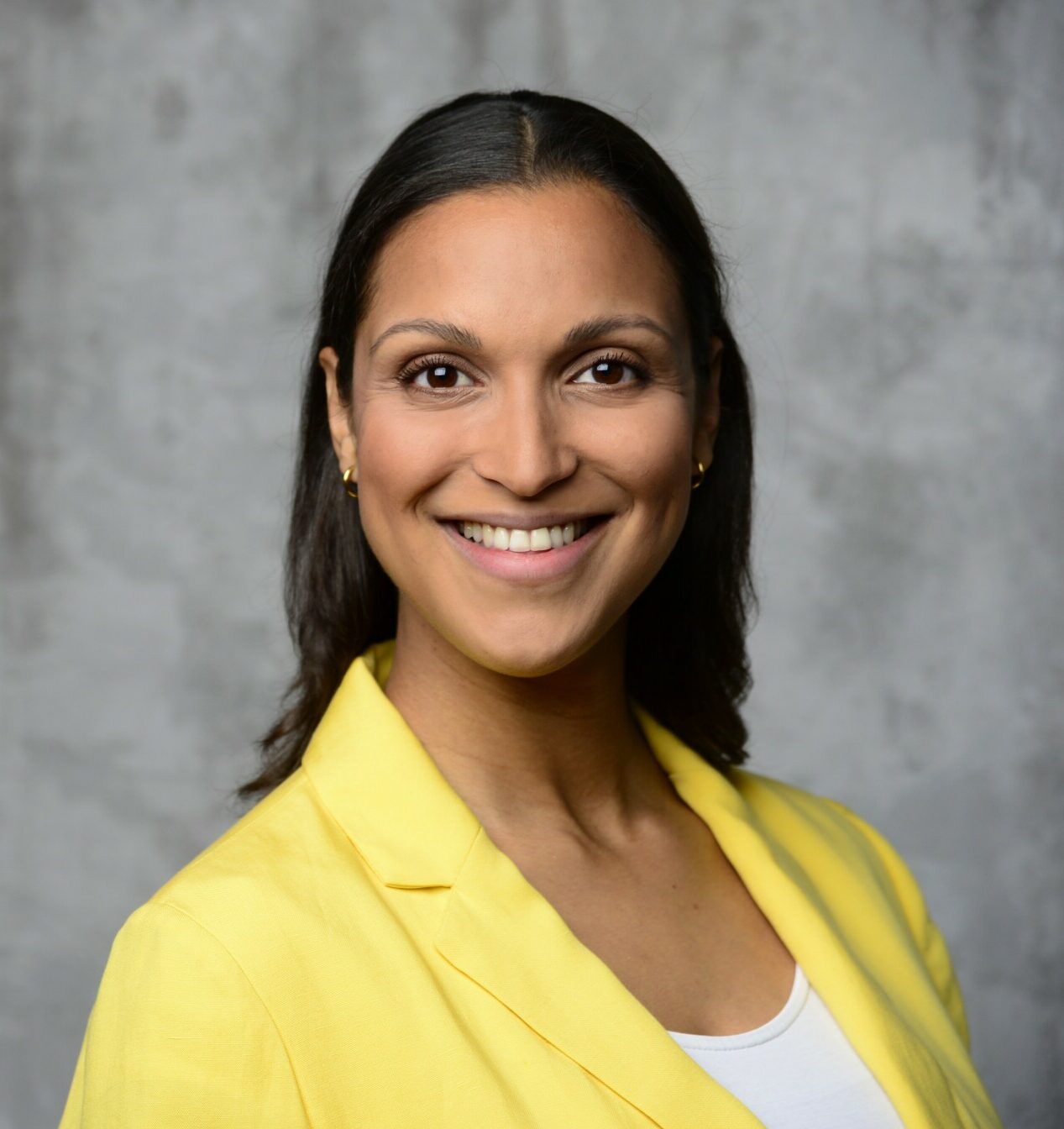German Tourism Analysis 2001
British American Tobacco presents the 17th German Tourism Analysis by the Leisure Research Institute.
Italy, Austria and Turkey on the rise – a setback for Spain and Germany in a slump.
The tourism industry can rest easy. While Germans' desire to travel hasn't increased further, it remains consistently high (1999: 521,300 – 2000: 521,300). And it knows no bounds: More and more are venturing abroad and turning their backs on their own country. More than two-thirds of holidaymakers (691,300) traveled abroad last season, while domestic travel reached its lowest level in ten years (1990: 431,300 – 1995: 371,300 – 2000: 311,300). In contrast, the holiday destinations of Italy, Austria, and Turkey are on the rise (each up 2 percentage points compared to the previous year). This is according to the 17th German Tourism Analysis by the Leisure Research Institute of British American Tobacco, in which 5,000 German citizens aged 14 and over were surveyed about their holiday behavior in 2000 and their travel intentions in 2001.
Spain, the top destination for German holidaymakers, experienced its first setback last season. The seemingly unstoppable climber (1995: 111,000 visitors – 1997: 151,000 visitors – 1999: 171,000 visitors) suddenly found itself slowing down (2000: 161,000 visitors). "In Spain, the first limits of mass tourism are becoming apparent," says institute director Prof. Dr. Horst W. Opaschowski. "Many holiday resorts in the Balearic and Canary Islands are considered overcrowded. So the tourist caravan is simply moving on." The most popular package holiday destination for Germans will have to contend with signs of market saturation in the coming years.
High energy costs, a strong US dollar, or a weak euro have so far had little impact on the travel decisions of Germans. Vacations lasting more than five days were just as popular last season as the previous year (1999: 521,300 – 2000: 521,300). This also applies to longer vacations lasting more than two weeks (1999: 421,300 – 2000: 421,300). However, travel intensity continues to reflect income levels in Germany. Among vacationers who can afford a longer trip lasting more than two weeks, higher earners with a household income of over DM 5,000 are still overrepresented (571,300 – under DM 2,000: 171,300). For every lower-income earner, there are more than three higher-income earners in the vacation travel market.
Domestic travel destinations 2000. North Sea and Baltic Sea coasts as top attractions.
Because domestic holiday regions are losing more and more market share in tourism, internal competition within Germany is also intensifying. Professor Opaschowski: "For years, a stable trend has been emerging: the coast is displacing the mountains. Waves, wind, sand, and beach chairs are the most popular choices for domestic holidaymakers." Despite strong domestic and international competition, the holiday regions on the North Sea coast were able to maintain their position last year (1999: 61,000 – 2000: 61,000). In contrast, the Baltic Sea holiday regions in Schleswig-Holstein and Mecklenburg-Western Pomerania experienced a slight decline in market share (1999: 81,000 – 2000: 61,000).
Since the early 1990s, almost all Alpine countries have suffered significant losses, including the Bavarian holiday regions, as well as Austria and Switzerland. There was talk of a general "Alpine fatigue." For example, the proportion of German tourists in Bavaria plummeted from 12 percent in 1991 to 8 percent in 1999. And there is still no end in sight to this downward trend. In the 2000 travel season, Eastern Bavaria, Upper Bavaria, and the Allgäu region experienced a further decline in market share, now down to 5 percent. Nevertheless, the Bavarian holiday regions, along with the North Sea and Baltic Sea coasts, remain among the most popular domestic travel destinations.
Domestic travel is becoming less and less popular.
Vacations in Germany are clearly becoming less popular. "A turnaround in the trend among German tourists is not in sight," says Prof. Dr. Opaschowski. "The only real hope for the future lies with foreign visitors, who are then lured to Sanssouci or Neuschwanstein as cultural tourists. For most Germans, domestic travel is their everyday reality, and the allure of distant lands only begins with a trip abroad. Unpredictable weather, high prices, and a lack of flexibility from providers are deterring more and more Germans from domestic travel.".
Over the past forty years, German travel patterns have been completely reversed. As recently as 1960, 69 percent of German vacationers stayed within Germany, while 31 percent traveled abroad. Last season, the situation was exactly the opposite: 69 percent of travelers abroad were contrasted with only 31 percent domestic tourists – the lowest figure ever recorded. And the trend of recent years has continued to fall (1998: 381,000 – 1999: 351,000 – 2000: 311,000). The outlook for the future is clear: Germany is becoming a destination for short breaks – for German citizens as well as for foreign city and cultural tourists.
Foreign travel destinations 2000. Spain loses market share.
In recent years, more and more German holidaymakers felt ready for the islands of the Mediterranean. The Balearic and Canary Islands were the undisputed leaders. Spain seemed destined for double-digit growth rates. The holiday destination boasted an unparalleled track record (1993: 101,300 visitors – 1995: 111,300 visitors – 1997: 151,300 visitors – 1999: 171,300 visitors). For the first time in a decade, Spain experienced a slight decline last season (2000: 161,300 visitors).
Spain will feel the growing popularity of Italian, Greek, and Turkish beach destinations even more in the future. Italy, in particular, is on the rise (1999: 71,000 visitors – 2000: 91,000 visitors). The results speak for themselves. Austria is also making a comeback (1999: 51,000 visitors – 2000: 71,000 visitors). A renaissance of this traditionally popular holiday destination for Germans is on the horizon, as it offers beautiful scenery, friendly staff, and a relaxed atmosphere. Turkey was also among the winners of the past season (1999: 31,000 visitors – 2000: 51,000 visitors), as was Greece (1999: 41,000 visitors – 2000: 51,000 visitors).
The long-haul travel market remains – for financial reasons alone – merely an attractive complement (and not an alternative) to Mediterranean holiday destinations. A major breakthrough is still pending. The Caribbean, particularly Cuba and the Dominican Republic, has stagnated for years (1991: 1% – 1996: 1% – 2000: 1%). Travel to the USA also remains a niche market (2000: 1%). Long-haul destinations will not be, and cannot be, a competitor to the classic travel destinations of Germans in the next decade.
Freedom of travel and its consequences: East German travel flows in a ten-year comparison (1990/2000)
With the achievement of freedom of travel, there has been an almost revolutionary shift in the direction of travel patterns among East Germans: from the Baltic Sea to the Mediterranean, with a preference for international rather than domestic travel. As recently as 1990 – the year of German reunification – the vast majority of East German travelers stayed in domestic holiday regions; ten years later, this figure had dropped to just 39 percent. In 1990, almost one in four East German vacationers (241,000) chose the Mecklenburg-Western Pomeranian Baltic coast as their destination, while in the 2000 travel season, this figure had fallen to a mere 8 percent. In contrast, East Germans are flocking en masse to Spain (1990: 31,000 – 2000: 91,000) and Austria (1990: 61,000 – 2000: 81,000). Italy (1990: 3% – 2000: 5%), Greece (1% – 4%), Scandinavia (1% – 4%) and Turkey (0% – 4%) follow at a considerable distance.
West and East German travel habits have largely converged over the past ten years. Both favor the same destinations, only occasionally exhibiting slightly different preferences. West Germans tend to choose more beach destinations (Baltic Sea, North Sea, Spain), while East Germans are more enthusiastic about mountains and lakes (Black Forest, Bavaria, Austria).
Travel plans for 2001: Cautiously optimistic.
How eager are Germans to travel in the coming season? Compared to last year, the desire to travel among Germans shows a slight upward trend (2000: 471,000 – 2001: 491,000). Almost half of all Germans want to get away or already have their bags packed. 49 percent of the population aged 14 and over, that is, over 31 million people, are firmly resolved to travel.
Another 27 percent (compared to 291 percent in 2000) are still undecided and don't know for sure whether they can or want to travel this year. Of course, travel intentions and actual travel behavior don't necessarily align. However, travel intentions reveal a great deal about economic sentiment, consumer priorities, and willingness to spend. There's certainly little cause for euphoria. Germans tend to adopt a stance somewhere between cautious and optimistic. This cautiously optimistic consumer attitude is something the travel industry can quite comfortably manage in the upcoming 2001 season.
Travel destinations 2001. Italy, Austria and Turkey particularly in demand.
And where should people travel in 2001? A representative survey conducted by the Leisure Research Institute on planned travel destinations for 2001 reveals that only one in five Germans with firm travel plans intends to stay within Germany (20%); all the rest are drawn to foreign countries. Professor Opaschowski: "Distance, warmth, and wide open spaces continue to define travel patterns for the coming season."„
Spain remains the top foreign travel destination. However, travel intentions here, too, show signs of restraint compared to last year. At the beginning of 2000, 16 percent of those surveyed expressed their intention to travel to Spain. By the end of that year, 16 percent of German holidaymakers had actually gone there. This year, only 15 percent cite it as a desired destination. Spain remains attractive, but will have to say goodbye to double-digit growth rates.
Compared to the previous year, Italy (2000: 81,300 visitors – 2001: 101,300 visitors), Austria (2000: 61,300 visitors – 2001: 71,300 visitors), and Turkey (2000: 41,300 visitors – 2001: 61,300 visitors) are particularly popular destinations for the upcoming travel season. Turkey is well on its way to regaining its market position in the Eastern Mediterranean. If holidaymakers follow through on their plans, the number of visitors to Turkey could increase by approximately 300,000, from 1.5 million to 1.8 million. In contrast, destinations such as the USA/Canada (21,300 visitors) or the Caribbean, including Cuba and the Dominican Republic (31,300 visitors), remain merely "long-haul" destinations: for many, more of a wish than a reality.
Save money on and during your vacation. Less shopping and fewer excursions – more affordable trips.
A representative sample of the population was asked which cost-saving measures they would most readily agree to during their vacation. A slight majority of Germans (541,000) are willing to embrace a new modesty while on holiday. Opaschowski: "Torn between the pressure to save and the hunt for bargains, vacationers are opting for the motto: Get away as quickly as possible – but more modestly at their destination." They are cutting back on shopping and souvenirs (1996: 191,000 – 2000: 201,000) or eating out less often (1996: 131,000 – 2000: 151,000). Day trips are suffering most from this new modesty at their holiday destinations. Six percent of respondents said they would take "fewer excursions" in 1996, and this figure had risen to ten percent by 2000.
Public trust in last-minute travel deals is surprisingly low (121 in both 1996 and 2000). Most Germans prefer to rely on their own frugality when it comes to vacations rather than on the travel industry's promise of getting a great vacation for little money at the last minute. Last-minute deals are primarily used by young people aged 18 to 24 (251 – compared to 121 in the rest of the population).
Over eleven million Germans (18%) currently set aside money specifically for their holidays. They use this extra savings to finance their next vacation. In addition, over 19 million Germans (31%) dip into their savings accounts to ensure they don't have to forgo their holidays. The older generation, aged 65 to 79, is most enthusiastic about the savings account idea (45%), while the younger generation, aged 14 to 24, relies more on their parents' holiday contributions (31%) than on their own savings (25%).
Holiday banking, a system of pre-financing vacations through loans and installments, is supposedly on the rise. In reality, this type of vacation financing has yet to gain traction in Germany (1%). When it comes to travel, Germans remain consistent: they usually only travel once they have earned or saved enough. The money has to be available beforehand – otherwise, they forgo the trip altogether.
Everyone want their own travel entrepreneur? Organized tours are trending.
78 percent of the population in Germany take a vacation trip occasionally or regularly. Of these, every second vacation trip is now a package tour. Back in 1970, it was only one in six (17%). In the 2000 travel season, package tours and independent travel were evenly matched for the first time, each accounting for 39 percent, while the remaining 22 percent of German citizens "have never taken a vacation trip of at least five days." The tourism industry's focus on quality is clearly paying off. The mass-market product of travel has now been individualized to such an extent that every traveler can satisfy their very personal needs for relaxation and experiences, convenience and comfort, while also fulfilling travel wishes in terms of time and budget. Institute Director Opaschowski: "The travel market has become an experience market of a thousand possibilities, achieving the seemingly impossible: It sells off-the-shelf freedom without the vacationer even noticing, even though they are aware of the commercial nature of vacations."„
Package deals – yet completely individual.
What even distinguishes a package tour from an individual trip anymore? The travel market is now divided into four groups, between which the boundaries are becoming increasingly blurred and the distinctions between "package" and "individual" are becoming ever more questionable.
This includes:
- Full-service travelers (34%) book a fully organized trip including transport and accommodation through a tour operator or travel agency and pay before departure. This travel type includes, in particular, singles (40%) and childless couples (44%), as well as higher earners (40%) with a net household income of over DM 5,000.
- Partially booked travelers (5%) book only a partially organized trip with a tour operator or travel agency; they organize the other part themselves. Self-employed individuals (10%) and senior managers (10%) are overrepresented in this group.
- Service travelers (4%) plan their route, destination, accommodation, and/or transport themselves, using the assistance of a travel agency during the preparation phase. Young people aged 18 to 24 (8%) and university graduates (9%) are most likely to make use of these services.
- Self-organizers (35%) are true do-it-yourselfers who plan and organize their entire trip from beginning to end themselves and carry it out completely without any help from a travel agency. Families with children (40%) prefer this type of travel because it offers a lot of freedom and can mostly be undertaken with their own car.
Professor Opaschowski: „In the upcoming 2001 travel season, there will be more package tourists than independent travelers in Germany for the first time. This is unprecedented in the history of modern tourism. Looking ahead, a trend is emerging: independent travelers are flocking to tour operators en masse.“ Organized tourism recognized the trend toward individualization in all areas of life early on and has moved away from rigid forms of offerings.
In the age of mass tourism, where everyone can travel anywhere at any time, the apparent contradictions dissolve. Almost half of all package tourists (46%), who have their entire trip organized for them, no longer feel restricted in their freedom of action. They confidently assert: "Even with a package tour, you can still tailor your vacation to your own individual needs." On the other hand, package tourists are also realists: Only about one in five (19%) can say: "I don't feel like a mass tourist. When I travel, I'm an individualist." And even those who organize their own trips or do-it-yourselfers see themselves critically as part of a tourism system: Even if millions of individualists travel – in the end, it always results in mass tourism.
Technical data of the TA 2001 survey. Results of the 17th German Tourism Analysis
Number and representativeness of respondents: Germany / 5000 people aged 14 and over
Survey period: January 6 to 22, 2001
Survey institute: INRA Germany, Society for Market and Social Research Ltd., Mölln
Additionally, a detailed data volume on the German Tourism Analysis (Travel Destinations 2000 and Travel Intentions 2001 of Germans) can be obtained under the title Travel Behavior 2000/Travel Intentions 2001 for the price of DM 398,–.
At the same time, the book "Das gekaufte Paradies. Tourismus im 21. Jahrhundert" (Germa Press Verlag Hamburg 2001) on the topic of package tourism is published in bookstores for DM 34.90.






